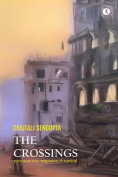Fierce Elegy by Peter Gizzi
 Middletown, Connecticut. Wesleyan University Press. 2023. 74 pages.
Middletown, Connecticut. Wesleyan University Press. 2023. 74 pages.
Fierce Elegy, by Peter Gizzi, is an impactful rumination of sixteen poems on the transformative capacity of myopic observations and the inherent shifts in perspective that carry these verses. The language is fired at the reader with deadly aim and intent, rooted in the senses with a contemporaneous language that silences and omits and invites us to engage with the subject matter in concrete clarity. Gizzi is writing with nothing to gain or lose, a poet for whom no idea is too large, no moment too small. The poems are unsurpassed. I trust in their weird and delightful imaginings of the moon, fields, art, night, and the unseen. Everything is made to happen evocatively, by implication of the oblique so that you take exploratory responsibility of the creative process, sensing the inspiration Gizzi has derived from various forms of art, accepting these as integral workings of his inner world. There is a sense of mystery and transcendence throughout the poems with their questioning of distance, both physical and emotional, demonstrating a stunning musical perceptiveness on a human scale.
In the first poem, “Findspot Unknown,” the speaker delves into the symbolic qualities of landscape. The silvered asphodel near the decrepit factory draws upon Greek mythology as a symbol of human-made ruin bringing life out of the afterlife: Gizzi places it back on this plane. The asphodel meadows are where ordinary souls find their eternal home in the afterlife. It is something eternalized by the salvation and decay of Earth itself, perhaps an undocumented record of time, the arena of the indecent eternal. As correlative, the asphodel connects the reader with this netherworld simultaneously within the living landscape. The language exhibits a pale, unassuming nature, which aligns with the poem’s notion of an uneventful afterlife for those who neither excelled nor gravely sinned during their mortal lives: “Landscape is a made thing, to see the mind seeing itself.” Gizzi elevates this meadow to become centrifugal, a testament to the resilience of Earth in the face of industrial decay. Upon acceptance, we take whatever the poem’s landscape happens to be on its own terms. He extends the symbolism by contrasting the deprivation of privacy in our eventual collective disappearance with a material that will likewise (and relatively quickly) go away: “And out of nothing, breath. A beast-like shadow in the glass.”
Nevertheless, “Spooky Action” explores a fervent desire to use language as a transformative force, making it an introspective celebration of the expressive possibilities inherent in language. In a plain, Anglo-Saxon lyric: “To be unleashed as a verb, Free to twirl, to disco, to walk away undone,” leaving the reader to ponder the burden of emotional language.
“The Posthumous Life of Childhood” expounds the transformation of soot into gravel in the mind, signaling a deterioration of clarity and the emergence of a “bad morning light.” The speaker likens themself to a refinery flame, a cylinder, a payload unto night, suggesting a sense of being consumed by the inexorable march of time. Overwhelmed by the intervening necessity to be in the present in this poem, Gizzi likens the feeling of living to a theater where lines are forgotten and the self is both stricken and limited by the hour. The acknowledgment of emptiness and the reference to body as an inner star both add a comical and cosmic dimension, suggesting that even in moments of limitation, there is a transcendent aspect to the self. The collection indeed shines even at the poems’ darkest moments, as suggested by the dark that grips the poems’ voice threading these ruminations together, reflecting a stark emotional landscape where, in particular, wind drives snow and the frozen “I” into a haunted stasis, a physical and emotional detention, almost paradoxically so. Or from Djuna Barnes’s Nightwood: “a cataleptic frozen gesture of abandon.”
Gizzi’s heart has flowered, uncompromising and completely memorable. He offers convergence where the thing itself becomes its own subject. In another poem, blurring the lines between viewer and viewed, the final lines sing: “There are so / many people here,” leaving us with a sense of plurality, a multitude of perspectives for us to acknowledge. Likewise suggesting the diverse narratives present within other artistic disciplines: “The dark octave unsettled. How far can vision take one, how far do we see into the painting thinking of painting.” Gizzi reminds us that all there is, is where we are now, that it has been bestowed upon us to appropriate in some measure his collection’s destiny.
Nicholas Skaldetvind
Stockholm University

![The cover to [...] by Fady Joudah](/sites/worldliteraturetoday.org/files/styles/backissue_small/public/Joudah.jpg?itok=HZO1_68A)

























